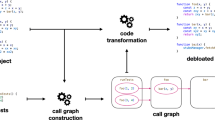Abstract
When reengineering a monolithic application to be a distributed one, programmers always have to decide how many distributed parts the application should be partitioned, and write many codes related to where a partwill be placed on network nodes and how these parts communicate with each other through the network. These codes usually have nothing to do with the business functions of the application, and they are laborious to write. In addition, as the distribution architecture of the application is finalized beforehand, it may not adapt well to the ever-changing execution environment. In this paper, we propose DPartner, an automatic partitioning system, to help programmers create a distributed Java application without explicitly writing the distribution-related codes. Unlike the other partitioning systems, DPartner does not partition an application directly into the coarse-grained client and server. Instead, it first partitions the application into several modules where each module performs a relatively independent business function of the application. Then it makes these modules be distributable through automatic bytecode rewriting. These modules can distribute in different nodes and cooperate to work just as the original monolithic application. Such a module-based partitioning approach enables a relatively easy reshaping of the distribution architecture of an application, which facilitates the application adapt to the environmental changes without manual recoding or repartitioning with regard to distribution. This paper gives the detailed design of DPartner, and evaluates it using real-world applications. The evaluation results demonstrate the effectiveness and efficiency of DPartner.
Similar content being viewed by others
References
Tilevich E, Smaragdakis Y. J-Orchestra: enhancing Java programs with distribution capabilities. ACM Transactions on Software Engineering and Methodology (TOSEM), 2009, 19(1): 1
Philippsen M, Zenger M. Javaparty-transparent remote objects in Java. Concurrency Practice and Experience, 1997, 9(11): 1225–1242
Wang L, Franz M. Automatic partitioning of object-oriented programs for resource-constrained mobile devices with multiple distribution objectives. In: Proceedings of the 14th IEEE International Conference on Parallel and Distributed Systems, ICPADS’08. 2008, 369–376
Messer A, Greenberg I, Bernadat P, Milojicic D, Chen D, Giuli T, Gu X. Towards a distributed platform for resource-constrained devices. In: Proceedings of the 22nd International Conference on Distributed Computing Systems, 2002. ICPADS’02. 2002, 43–51
Cuervo E, Balasubramanian A, Cho D, Wolman A, Saroiu S, Chandra R, Bahl P. Maui: making smartphones last longer with code offload. In: Proceedings of the 8th International Conference on Mobile Systems, Applications, and Services. 2010, 49–62
Åhlund A. An approach towards user-centric application mobility. Master Thesis, Umea University, Sweden, 2009
Riva O, Nadeem T, Borcea C, Iftode L. Context-aware migratory services in ad hoc networks. IEEE Transactions on Mobile Computing, 2007, 6(12): 1313–1328
Åhlund A, Mitra K, Johansson D, Åhlund C, Zaslavsky A. Contextaware application mobility support in pervasive computing environments. In: Proceedings of the 6th International Conference on Mobile Technology, Application & Systems. 2009, 21
OSGi. http://www.osgi.org
Eclipse and Equinox. http://www.eclipse.org
Felix. http://felix.apache.org
Arisholm E, Briand L, Foyen A. Dynamic coupling measurement for object-oriented software. IEEE Transactions on Software Engineering, 2004, 30(8): 491–506
Call Graph. http://en.wikipedia.org/wiki/Call_graph
Maletic J, Marcus A. Supporting program comprehension using semantic and structural information. In: Proceedings of the 23rd International Conference on Software Engineering. 2001, 103–112
Girvan M, Newman M. Community structure in social and biological networks. Proceedings of the National Academy of Sciences of the United States of America, 2002, 99(12): 7821–7826
Han J, Kamber M. Data Mining: Concepts and Techniques. Morgan Kaufmann, 2006
Tilevich E, Smaragdakis Y. Portable and efficient distributed threads for Java. Middleware 2004, 2004, 478–492
JBoss. http://www.jboss.org
JOnAS. http://jonas.ow2.org
Shen J, Sun X, Huang G, Jiao W, Sun Y, Mei H. Towards a unified formal model for supporting mechanisms of dynamic component update. In: Proceedings of ACM SIGSOFT Software Engineering Notes. 2005, 80–89
Gu X, Nahrstedt K, Messer A, Greenberg I, Milojicic D. Adaptive offloading for pervasive computing. IEEE Pervasive Computing, 2004, 3(3): 66–73
Hunt G, Scott M. The coign automatic distributed partitioning system. Operating Systems Review, 1998, 33: 187–200
COM and DCOM. http://www.microsoft.com/com
Rellermeyer J, Alonso G, Roscoe T. R-OSGi: distributed applications through software modularization. In: Proceedings of the ACM/IFIP/USENIX 2007 International Conference on Middleware. 2007, 1–20
Lobosco M, Silva A F, Loques O, Amorim C L. A new distributed jvm for cluster computing. Euro-Par 2003 Parallel Processing, 2003, 1207–1215
Yu W, Cox A. Java/dsm: a platform for heterogeneous computing. Concurrency: Practice and Experience, 1997, 9(11): 1213–1224
Jade. http://en.wikipedia.org/wiki/Java_Agent_Development_Framework
Author information
Authors and Affiliations
Corresponding author
Additional information
Ying ZHANG received his PhD in 2012 from the School of Electronics Engineering and Computer Science of Peking University. He is now a research staff of Peking University. Zhang’s research interests include system software and software architecture.
Gang HUANG received his PhD in 2003 from the School of Electronics Engineering and Computer Science of Peking University. He is a professor of Peking University. Huang’s research interests include system software and software architecture.
Wei ZHANG is a master candidate at School of Electronics Engineering and Computer Science, Peking University. Zhang’s research interests include system software, software engineering, software architecture and mobile computing.
Xuanzhe LIU received his PhD in 2009 from the School of Electronics Engineering and Computer Science of Peking University. He is now an associate professor of Peking University. Liu’s research interests include system software and services.
Hong MEI is an Academician of Chinese Academy of Science. He is also a professor of Peking University, and the dean of the School of Electronics Engineering and Computer Science of Peking University. Mei’s research interests include system software and software architecture.
Rights and permissions
About this article
Cite this article
Zhang, Y., Huang, G., Zhang, W. et al. Towards module-based automatic partitioning of Java applications. Front. Comput. Sci. 6, 725–740 (2012). https://doi.org/10.1007/s11704-012-2220-x
Received:
Accepted:
Published:
Issue Date:
DOI: https://doi.org/10.1007/s11704-012-2220-x




